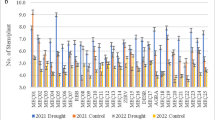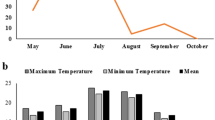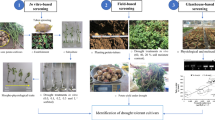Abstract
Sixteen potato genotypes were assessed for drought tolerance through morphophysiological characteristics using stress tolerance trait index (STTI), principal component analysis (PCA), and cluster analysis (CA). Two to three wk old nodal segments explants (1.0 to 2.0 cm long) derived from in vitro grown sprouts were cultured on MS medium that contained with different concentrations of sorbitol. After 6 wk of culture initiation, the length of shoots, roots, and internodes; thickness of shoot and roots; number of leaves and roots; fresh and dry weight of whole plant; and water content of plants were recorded. For PCA, the cultivars Arun, Granola, Surjomukhi, Sheelbilati, Jamalu, Chollisha, Patnai, and Dohazari showed relatively higher values regarding drought tolerance and Diamant, Asterix, Courage, Cardinal, Lalpakri, Sindurkouta, Ausha, and Sadaguti were drought-sensitive cultivars. For cluster analysis, the cultivars Arun, Granola, and Surjomukhi showed high tolerances to drought and Diamant was sensitive. Analysis of variance (ANOVA), Duncan’s multiple range test (DMRT), and correlation coefficient for different morphological and physiological traits showed significantly higher values at p < 0.01 level among the tested genotypes. The protocols standardized under this study may be helpful for plant breeders and biotechnologist to develop mass production of potato seeds/tubers in drought-prone areas.





Similar content being viewed by others
References
Aghaei K, Ehsanpour AA, Balali G, Mostajeran A (2008) In vitro screening of potato (Solanum tuberosum L.) cultivars for salt tolerance using physiological and RAPD analysis. Am Eur J Agric Env Sci 3:159–164
Al-Ashkar I, Alderfasi A, El-Hendawy S, Al-Suhaibani N, El-Kafafi S, Seleiman MF (2019) Detecting salt tolerance in doubled haploid wheat lines. Agronomy 9:1–24
Albiski F, Najla S, Sanoubar R, Alkabani N, Murshed R (2012) In vitro screening of potato lines for drought tolerance. Physiol Mol Biol Plants 18:315–321
Anithakumari AM (2011) Genetic dissection of drought tolerance in potato, Ph.D thesis, Wageningen University, Wageningen, NL, pp 152
Ashraf M (1994) Breeding for salinity tolerance in plants. Crit Rev Plant Sci 13:17–42
Basak JK (2011) Implications of climate change on crop production in Bangladesh and possible adaptation techniques. In: international conference on United Nations framework convention on climate change, Durban exhibition Centre, Durban, COP 17. Unnayan Onneshan - the innovators, Bangladesh
Boyer JS (1982) Plant productivity and environment. Science 218:443–448
Coleman WK (2008) Evaluation of wild Solanum species for drought resistance: 1. Solanum gandarillasii Cardenas. Environ Exp Bot 62:221–230
Dahal K, Li X-Q, Tai H, Creelman A, Bizimungu B (2019) Improving potato stress tolerance and tuber yield under a climate change scenario- a current overview. Front Plant Sci 10:1–16
Farshadfar E, Amiri R (2016) In vitro application of integrated selection index for screening drought tolerant genotypes in common wheat. Acta Agr Slovenica 107:335–344
Feng X, Zhao P, Hao J, Hu J, Kang D, Wang H (2011) Effect on sorbitol on expression of genes involved in regeneration of upland rice (Oryza sativa L.). Plant Cell Tiss Org Cult 106:455–463
Flowers TJ, Yeo AR (1989) Effect of salinity on plant growth and crop yield. In: Cherry J (ed) Biochemical and physiological mechanisms associated with environmental stress tolerance in plants. Springer-Verlag, Berlin, pp 151–165
Frensh J (1997) Primary response of root and leaf elongation to water deficits in the atmosphere and soil solution. J Exp Bot 48:985–999
Ghaffari M, Toorchi M, Valizadeh M, Shakiba MR (2012) Morpho-physiological screening of sunflower inbred lines under drought stress condition. Turkish J Field Crops 17:185–190
Gill SS, Tuteja N (2010) Polyamines and abiotic stress tolerance in plants. Plant Sign Behav 5:26–33
Gopal J, Iwama K (2007) In vitro screening of potato against water stress mediated through sorbitol and polyethylene glycol. Plant Cell Rep 26:693–700
Gopal J, Iwama K, Jitsuyama Y (2008) Effect of water stress mediated through agar on in vitro growth of potato. In Vitro Cell Dev Biol - Plant 44:221–228
Grzesiak S, Hordyńska N, Szczyrek P, Grzesiak MT, Noga A, Szechyńska-Hebda M (2019) Variation among wheat (Triticum easativum L.) genotypes in response to the drought stress: I-selection approaches. J Plant Inter 14:30–44
Harun-Or-Rashid M, Islam SMS, Bari MA (2020) In vitro screening for salt stress tolerance of native and exotic potato genotypes by various morphological and physiological parameters. J Bio Sci 28:21–32
Hasan MK, Nasiruddin KM, Al-Amin M, Hossain AKMS (2016) In vitro screening of soybean genotypes under salinity stress. Int J Appl Sci Biotech 4:207–212
Hassan NM, Serag MS, El-Feky FM (2004) Changes in nitrogen content and protein profiles following in vitro selection of NaCl resistant mung bean and tomato. Acta Physiol Plant 26:165–175
Hassanpanah D, Gurbanov E, Gadimov A, Shahriari R (2008) Determination of yield stability in advanced potato cultivars as affected by water deficit and potassium humate in Ardabil region, Iran. Pak J Biol Sci 15:1354–1359
Iezzoni AF, Pritts MP (1991) Applications of principal component analysis to horticultural research. Hort Sci 26:334–338
Iwama K, Yamaguchi J (2006) Abiotic stresses. In: Gopal J, Khuran SM Paul (Eds), handbook of potato production, improvement and postharvest management. Food Product Press, New York, pp 231–278
Jain M, Tiwary S, Gadre R (2010) Sorbitol-induced changes in various growth and biochemical parameters in maize. Plant Soil Env 6:263–267
Kebede Z, Mekbib F, Desta T, Asfaw A (2019) Drought resistance indices for screening of potato (Solanum tuberosum L.) genotypes. Turkish J Agr - Food Sci Tech 7:1118–1124
Labeb RK, Zaki HEM, Abdel-Ati YY, Zaky MH (2020) In vitro screening of potato (Solanum tuberosum L.) cultivars for drought stress tolerance. SVU-Intl J Agri Sci 2:53–61
Levy D (1992) The response of potatoes (Solanum tuberosum L.) to salinity: plant growth and tuber yields in the arid desert of Israel. Annals Appl Biol 120:547–555
Murashige T, Skoog F (1962) A revised medium for rapid growth and bioassay with tobacco tissue culture. Plant Physiol 15:473–497
Nouraein M, Mohammadi SA, Aharizad S, Moghaddam M, Sadeghzadeh B (2013) Evaluation of drought tolerance indices in wheat recombinant inbred line population. Ann Biol Res 4:113–122
Rampino P, Pataleo S, Gerardi C, Mita G, Perrotta C (2006) Drought stress response in wheat: physiological and molecular analysis of resistant and sensitive genotypes. Plant Cell Env 29:2143–2152
Ranalli P, Di-Candilo M, Ruaro G, Marino A (1996) Drought effects on chlorophyll fluorescence and canopy temperature. 14th Triennial Conference of the European Association for Potato Research, 2–7 May 1996, Sorrento, Italy
Sanchez-Rodriguez E, Rubio-Wilhelmi MM, Cervilla LM, Blasco B, Rios JJ, Rosales MA, Romero L, Ruiz JM (2010) Genotypic differences in some physiological parameters symptomatic for oxidative stress under moderate drought in tomato plants. Plant Sci 178:30–40
Schittenhelma S, Sourell H, Lopmeierc F (2006) Drought resistance of potato cultivars with contrasting canopy architecture. Eur J Agron 24:193–202
Seraj ZI, Lisa LA, Islam MR, Begum R, Das DK (2006) Genetic diversity of saline costal rice (Oriza sativa L.) landraces of Bangladesh. In: Rai AK, Takabe T (eds) Abiotic stress tolerance in plants. Springer, Netherlands, pp 230–244
Shahzad A, Ahmad M, Iqbal M, Ahmed I, Ali GM (2012) Evaluation of wheat land race genotypes for salinity tolerance at vegetative stage by using morphological and molecular markers. Genet Mol Res 11:679–692
Steckel JR, Gray D (1979) Drought tolerance of potatoes. J Agr Sci 47:770–775
Tican A, Cioloca M, Chiru N, Bădărău C (2016) Influence of different in vitro simulators for hydric stress for growth and development of potato. Sci Bull Series F Biotech 20:105–112
Vashisht AA, Tuteja N (2006) Stress responsive DEAD box helicases: a new pathway to engineer plant stress tolerance. J Photochem Photobiol B: Biology 84:150–160
Villordon AQ, Ginzberg I, Firon N (2014) Root architecture and root tuber crop productivity. Trends Plant Sci 19:419–425
Wang W, Vinocur B, Altman A (2003) Plant responses to drought, salinity and extreme temperatures: towards genetic engineering for stress tolerance. Planta 218:1–14
Ward JH (1963) Hierarchical grouping to optimize an objective function. J Am Stat Assoc 58:236–244
Witcombe JR, Hollington PA, Howarth CJ, Reader S, Steele KA (2008) Breeding for abiotic stresses for sustainable agriculture. Phil Trans R Soc B 363:703–716
Yan W, Kang MS (2003) Biplot analysis: a graphical tool for breeders. CRC Press, Boca Raton, FL, Geneticists and Agronomist, p 313
Yang B, Tang J, Yu Z, Khare T, Srivastav A, Datir S, Kumar V (2019) Light stress responses and prospects for engineering light stress tolerance in crop plants. J Plant Growth Regul 38:1489–1506
Yousuf PY, Hakeem KUR, Chandna R, Ahmad P (2012) Role of glutathione reductase in plant abiotic stress. In: Ahmad P, Prasad MNV (eds) Abiotic stress response in plants: metabolism, Productivity and Sustainability. Springer Science and Business Media, pp 149–157
Zaheri A, Bahraminejad S (2012) Assessment of drought tolerance in oat (Avena sativa L.) genotypes. Ann Biol Res 3:2194–2201
Zarzynska K, Boguszewska-Mankowska D, Nosalewicz A (2017) Differences in size and architecture of the potato cultivars root system and their tolerance to drought stress. Plant Soil Environ 63:159–116
Acknowledgments
The authors gratefully acknowledges to Plant Biotechnology and Genetic Engineering Laboratory, Institute of Biological Sciences, University of Rajshahi, for research facilities and the HEQEP (CP-2485), University Grants Commission of Bangladesh, for providing fellowship of this study.
Author information
Authors and Affiliations
Contributions
SMS Islam and MA Bari Miah provided lab and other facilities and supervised the works. Study design and concept of the research was given by SMS Islam and the article was critically revised by him. M Harun-Or-Rashid carried out the experiment; data analyzed statistically and made the draft.
Corresponding author
Ethics declarations
Conflict of interest
The authors declare that there is no competing interest.
Rights and permissions
About this article
Cite this article
Harun-Or-Rashid, M., Miah, M.B. & Islam, S.S. In vitro morphophysiological screening of drought-tolerant potato genotypes. In Vitro Cell.Dev.Biol.-Plant 57, 519–528 (2021). https://doi.org/10.1007/s11627-020-10155-z
Received:
Accepted:
Published:
Issue Date:
DOI: https://doi.org/10.1007/s11627-020-10155-z




